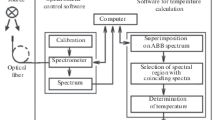Abstract
A high-speed interferometric technique has been developed at the National Institute of Standards and Technology to measure thermal expansion of metals between room temperature and temperatures primarily in the range 1500 K to near their melting points. The basic method involves resistively heating the specimen from room temperature up to and through the temperature range of interest in less than 1 s by passing an electrical current pulse through it and simultaneously measuring, with submillisecond resolution, the specimen temperature by means of a high-speed photoelectric pyrometer and the shift in the fringe pattern produced by a Michelson-type interferometer. The polarized beam from a He-Ne laser in the interferometer is split into two components, one which undergoes successive reflections from highly polished flats on opposite sides of the specimen and one which serves as the reference beam. The linear thermal expansion of the specimen is determined from the cumulative fringe shift corresponding to each measured temperature. The technique is capable of measuring linear thermal expansion with a maximum estimated uncertainty which ranges from about 1% at 2000 K to approximately 2% at 3600 K. Measurements have been performed on the refractory metals, niobium, molybdenum, tantalum, and tungsten, yielding thermal expansion data in the temperature range 1500 K up to near their respective melting points. Also, the technique has been used to follow the rapid dimensional changes that occur during solid-solid phase transformations; in particular, the α→γ transformation in iron has been studied.
Similar content being viewed by others
References
A. P. Miiller and A. Cezairliyan, Int. J. Thermophys. 3:259 (1982).
A. Cezairliyan, M. S. Morse, H. A. Berman, and C. W. Beckett, J. Res. Natl. Bur. Stand (U.S.) 74A:65 (1970).
A. Cezairliyan, J. Res. Natl. Bur. Stand. (U.S.) 75C:7 (1971).
A. P. Miiller and A. Cezairliyan, Int. J. Thermophys. 6:695 (1985).
A. P. Miiller and A. Cezairliyan, Int. J. Thermophys. 9:195 (1988).
A. P. Miiller and A. Cezairliyan, Int. J. Thermophys. 11:619 (1990).
A. P. Miiller and A. Cezairliyan, in Thermal Expansion 8, T. A. Hahn, ed. (Plenum Press, New York, 1984), p. 245.
G. M. Foley, Rev. Sci. Instrum. 41:827 (1970).
Office of Standard Reference Materials, NBS Standard Reference Materials Catalog, 1988–89 ed., NBS Special Publication 260 (U.S. Government Printing Office, Washington, D.C., 1988).
R. K. Kirby and T. A. Hahn, SRM 737 Certificate (Office of Standard Reference Materials, Natl. Bur. Stand. (U.S.), 1976).
Author information
Authors and Affiliations
Rights and permissions
About this article
Cite this article
Miiller, A.P., Cezairliyan, A. Interferometric technique for the subsecond measurement of thermal expansion at high temperatures: Applications to refractory metals. Int J Thermophys 12, 643–656 (1991). https://doi.org/10.1007/BF00534220
Issue Date:
DOI: https://doi.org/10.1007/BF00534220



